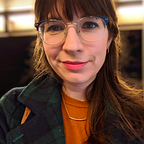How The New York Times helped me rethink journalism…
…by inspiring me to teach myself to code.
I started my career as a photographer. I love exploring the world around me and asking tough questions. I grew up idolizing work in the New York Times, National Geographic and, of course, the Milwaukee Journal Sentinel, whose team brought all the realities of my city into sharp clarity and gave our home in the Midwest a larger voice.
After studying photography, freelancing as a photojournalist, and getting a degree in journalism, I began blogging. I was frustrated with the limitations of print journalism and wanted to explore a little bit. It was the first time I had seen any computer code, and it completely blew my mind. With no real idea where to start, I dug into my WordPress site, teaching myself HTML and CSS.
Then, in 2012, The New York Times published “Snow Fall.” It was the first time I had seen graphics, photo galleries, videos and written content pulled together so seamlessly. “Snow Fall” showed me that you didn’t have to choose a medium anymore. You could let each part of a story tell itself in the most effective way, and that users could glide between each part of the story effortlessly. It was thrilling to see the future of journalism right there in front of me. I knew that if I was going to keep telling stories, I wanted to tell them that way, working in a multimedia, digital space.
- In 2013–2014, as Ellen Barry brought us “The Russia Left Behind,” I started teaching myself JavaScript. Working as a digital editor for our local PBS station, Wisconsin Public Television, I was lucky enough to have an incredible mentor who spent hours teaching me some of the basics about the architecture of the Internet.
- In 2015–2016 as the Associated Press and The New York Times kept us all up to date on the upcoming presidential election, I joined Free Code Camp. I moved to New York, where I began working for WNET, learning what production on a national scale looks like and how many people it takes to bring a truly multi-platform project to fruition.
- In 2017–2018 as Ron Stodghill brought us “Harriett Tubman’s Path to Freedom,” I wrapped up production on my first web series and decided to take the plunge, signing up for Fullstack Academy’s Grace Hopper Program and committing to a career change.
Now, as The New York Times is moving into augmented reality, I’m moving into software engineering. I’ve finished the bootcamp, am working as a teaching fellow, and can feel something has shifted. Every day is a rewarding challenge, and I’m looking at stories from a new, more technical perspective, pushing myself out of my comfort zone.
I’m not sure what journalism will look like in five years, and I certainly don’t know where I will be. I might be working in data visualization, machine learning or cloud computing; I might be working with blockchain technology or augmented reality. Whatever I’m exploring, it’s thanks to the many writers and creators at The New York Times that I know I will be contributing to inventive and powerful communication.
It’s because of their constant innovation that I am excited about the possibilities in front of us — our ability to evolve with the world around us and keep telling important stories — because whichever platform I’m working on, I am still (and will always be) a storyteller.
